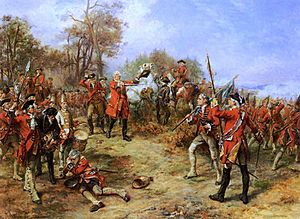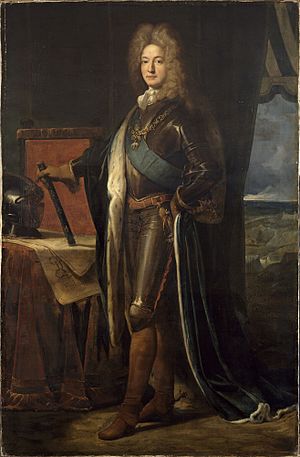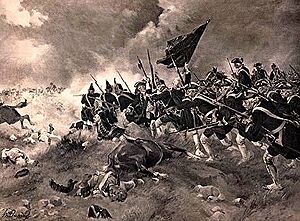Battle of Dettingen facts for kids
Quick facts for kids Battle of Dettingen |
|||||||
|---|---|---|---|---|---|---|---|
| Part of War of the Austrian Succession | |||||||
 George II at Dettingen |
|||||||
|
|||||||
| Belligerents | |||||||
| Commanders and leaders | |||||||
| Strength | |||||||
| 35,000–50,000 | 23,000-70,000 | ||||||
| Casualties and losses | |||||||
| 2,332 | 3,000–4,500 | ||||||
The Battle of Dettingen was a major fight that happened on June 27, 1743. It took place in a small town called Dettingen, which is now in Germany. This battle was part of a bigger conflict known as the War of the Austrian Succession.
The battle was fought between two main groups. One side was called the Pragmatic Army. It included soldiers from Britain, Hanover (a German state), and Austria. Their opponents were the French army.
What makes this battle special is that King George II of Great Britain actually led his troops into combat. He was the last British king to do so! Even though the Allies won, the battle didn't change the overall war much. Some people even called it "a lucky escape" rather than a huge victory.
Contents
Why Did the Battle Happen?

The Battle of Dettingen was part of the War of the Austrian Succession. This war started because of a disagreement over who should rule Austria. In 1740, the ruler of Austria, Emperor Charles VI, died. He had no sons, only a daughter named Maria Theresa.
Normally, women were not allowed to inherit the throne in Austria. But a special rule, called the Pragmatic Sanction of 1713, said Maria Theresa could become queen. However, some rulers, like Charles Albert of Bavaria, disagreed. He believed he should be the next ruler.
This family dispute quickly grew into a big European war. Austria was a very powerful part of the Holy Roman Empire, which was a group of mostly German states. Many countries chose sides. France, Prussia, and Bavaria supported Charles Albert. Britain, Hanover, and the Netherlands supported Maria Theresa. These countries were called the Pragmatic Allies.
In 1742, Austria's situation looked bad. But they made peace with Prussia. Then, they started winning battles against Bavaria. By June 1743, the Allied army, including King George II, was in Germany. They were running low on food and supplies. They needed to get to a supply base in a town called Hanau.
The road to Hanau went right through Dettingen. The French commander, Duc de Noailles, saw a chance to trap the Allied army. He sent about 23,000 French troops to block the road at Dettingen.
How the Battle Unfolded
Early on June 27, the Allied army left Aschaffenburg, heading for Hanau. They marched along the north side of the Main River. The French were waiting for them in a very strong position at Dettingen.
The French had their soldiers lined up from the village to some nearby hills. Their cavalry (soldiers on horseback) were on flat ground. The French commander, Noailles, also placed cannons on the other side of the river. These cannons could fire directly into the Allied army's side.
The Allies were surprised by the French. They didn't know the French were there in such large numbers. Their situation became even more dangerous when Noailles sent another 12,000 French troops across the river. These troops were meant to attack the Allied army from behind.
The Allied commander ordered some British and Hanoverian soldiers to go back. The rest of the army changed their formation to attack the French. As they moved, the French cannons fired at them, but luckily, not many soldiers were hurt.
Around midday, something unexpected happened. The French cavalry, known as the Maison du Roi, suddenly charged the Allied lines. Their commander, Noailles, had told them to hold their position three times. But they charged anyway, perhaps hoping to win the battle on their own.
This charge broke through the first few lines of the Allied army. It caused some confusion among the less experienced British cavalry. The French infantry (foot soldiers) then followed with their own attack. This forced the French cannon fire to stop, as they risked hitting their own troops.
This pause allowed the British foot soldiers to hold their ground. A Hanoverian cannon unit started firing at the French from close range. An Austrian group of soldiers also attacked the French from the side. After about three hours of fighting, the French had to retreat. Many of their soldiers were hurt when one of the bridges they were using to cross the river collapsed.
The Allied army continued their march towards Hanau. Even though they won, they were not in a good position to chase the French. They were still low on supplies. They even had to leave their wounded soldiers behind to move faster.
What Happened After the Battle?
King George II gave many awards and promotions to his officers after Dettingen. However, many people saw the battle as a lucky escape rather than a great victory. The Allied army was forced to retreat because they lacked supplies. They could have lost badly if the French commander's orders had been followed.
After the battle, the Allies couldn't agree on how to use their victory. So, they didn't do much and settled down for the winter in the Netherlands.
The Battle of Dettingen was the last battle for several important officers. The French commander, Noailles, became a foreign minister in 1744. Another French leader, de Gramont, died in a later battle in 1745. The Allied cavalry didn't perform very well in the battle. They failed to find the large French army blocking their path. Many riders also had trouble controlling their horses.
It was the training and discipline of the Allied infantry (foot soldiers) that saved the army. Because of this, one of the training companies at the Royal Military Academy Sandhurst is named 'Dettingen' to honor their bravery.
To celebrate the victory and honor King George II, the famous composer Handel wrote two pieces of music: the Dettingen Te Deum and the Dettingen Anthem.
Images for kids




